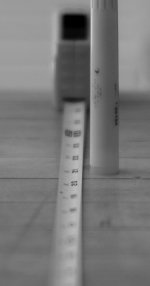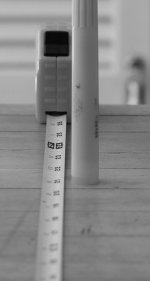tbarker13
shooter of stuff
I am about to send my 50 Sonnar off to Zeiss for the adjustment of the focus shift. Thought I would post a few "Before" photos demonstrating the shift from f/1.5 to f/4.0.
These shots are of a small statue in my back yard, with my garage in the background. The M8 was mounted on a tripod, five feet from the statue. Shots are taken at f1.5, f/2.8 and f4.0. ( I have shots at 2.0, 5.6 and 8.0, but the post limits me to three shots)
I plan to recreate these same images after the lens is returned to me by Zeiss.
I don't know if this has any value to anyone. But I just thought I'd post my experience here in case anyone else is considering the same adjustment.



f 1.5................ f/2.8 ............f/4.0
These shots are of a small statue in my back yard, with my garage in the background. The M8 was mounted on a tripod, five feet from the statue. Shots are taken at f1.5, f/2.8 and f4.0. ( I have shots at 2.0, 5.6 and 8.0, but the post limits me to three shots)
I plan to recreate these same images after the lens is returned to me by Zeiss.
I don't know if this has any value to anyone. But I just thought I'd post my experience here in case anyone else is considering the same adjustment.



f 1.5................ f/2.8 ............f/4.0
Last edited:
Avotius
Some guy
I dont see the problem, they all seem to be fine, why are you sending it to zeiss?
tbarker13
shooter of stuff
Perhaps I should have used a different subject. But I can see a definite front focusing on images at f 1.5 and f 2.0. It is gone at f 2.8 and beyond.
From Zeiss:
"Well, of course the focus shift still exists after re-adjusting the lens, but will not be visible at f/1.5. When you stop down to f/2.8 or smaller, there will be visible a slight focus shift, but sharpness will be covered within the depth-of-field. In practical use, after the adjustment the focus shift will not play an important role anymore."
They say it takes about 10 days for the adjustment.
From Zeiss:
"Well, of course the focus shift still exists after re-adjusting the lens, but will not be visible at f/1.5. When you stop down to f/2.8 or smaller, there will be visible a slight focus shift, but sharpness will be covered within the depth-of-field. In practical use, after the adjustment the focus shift will not play an important role anymore."
They say it takes about 10 days for the adjustment.
visiondr
cyclic iconoclast
Yup, the front focusing is there at 1.5. The hand is in focus but the face is slightly off.
FanMan
Established
I can see the front focus, too.
It would be great if you could share your experiences with us by posting some sample shots taken after the re-adjustment of the lens by Zeiss.
How much are the cost of the re-adjustment?
Michael
It would be great if you could share your experiences with us by posting some sample shots taken after the re-adjustment of the lens by Zeiss.
How much are the cost of the re-adjustment?
Michael
40oz
...
IMHO, some people see what they want to see.
back alley
IMAGES
From Zeiss:
"Well, of course the focus shift still exists after re-adjusting the lens, but will not be visible at f/1.5. When you stop down to f/2.8 or smaller, there will be visible a slight focus shift, but sharpness will be covered within the depth-of-field. In practical use, after the adjustment the focus shift will not play an important role anymore."
i still don't understand why on earth they set up the lens to front focus at 1.5?! what was the rationale?
"Well, of course the focus shift still exists after re-adjusting the lens, but will not be visible at f/1.5. When you stop down to f/2.8 or smaller, there will be visible a slight focus shift, but sharpness will be covered within the depth-of-field. In practical use, after the adjustment the focus shift will not play an important role anymore."
i still don't understand why on earth they set up the lens to front focus at 1.5?! what was the rationale?
xayraa33
rangefinder user and fancier
I too also wonder what the rationale was by the Zeiss engineers and designers to produce a fast expensive 50mm lens that front focuses at f1.5? ... as if the f 1.5 opening is not going to be used.
since the problem can be semi corrected or a lesser of an evil trade off can made,are the new current C f 1.5 Sonnars coming off the assembly line corrected or adjusted for this serious problem?
people are holding back from buying this lens because of all this mess.
I expect better from Zeiss.
since the problem can be semi corrected or a lesser of an evil trade off can made,are the new current C f 1.5 Sonnars coming off the assembly line corrected or adjusted for this serious problem?
people are holding back from buying this lens because of all this mess.
I expect better from Zeiss.
tbarker13
shooter of stuff
"IMHO, some people see what they want to see."
Perhaps some others have copies of the lens that don't have the shift. I can oply speak for the one in my hands right now.
I did some pretty extensive testing of this lens last weekend - I wanted to be sure before I decided to send it off. There is a distinct shifting at f/1.5 and f/2.0 on my copy of this lens.
I started working on a technique where I focused on my subject, and then leaned forward a few inches before releasing the shutter. That helped, but was very in-exact.
I still love the lens. I think I'll like it much better when I can trust it wide open.
Perhaps I will add something to my little test that makes a better subject. I'll see what I can come up with today.
Perhaps some others have copies of the lens that don't have the shift. I can oply speak for the one in my hands right now.
I did some pretty extensive testing of this lens last weekend - I wanted to be sure before I decided to send it off. There is a distinct shifting at f/1.5 and f/2.0 on my copy of this lens.
I started working on a technique where I focused on my subject, and then leaned forward a few inches before releasing the shutter. That helped, but was very in-exact.
I still love the lens. I think I'll like it much better when I can trust it wide open.
Perhaps I will add something to my little test that makes a better subject. I'll see what I can come up with today.
back alley
IMAGES
but it seems odd to make it front focus at 1.5 when dof might cover more sins if set to front focus at smaller f stops.
and if they can offer to change it on individual lenses then the question i have is what was the rationale for picking 1.5?
and if they can offer to change it on individual lenses then the question i have is what was the rationale for picking 1.5?
visiondr
cyclic iconoclast
Tim,
Thank you for the test. This lens has been on my want/need/desire list for some time. I may have to rethink that. The 50/2 planar is probably a better choice for me.
Thank you for the test. This lens has been on my want/need/desire list for some time. I may have to rethink that. The 50/2 planar is probably a better choice for me.
xayraa33
rangefinder user and fancier
How did Zeiss set up the original f1.5 Sonnar for the Contax II
and the postwar Opton version for the IIa?
is there any front focus problems with these Sonnars?
and the postwar Opton version for the IIa?
is there any front focus problems with these Sonnars?
FanMan
Established
back alley said:From Zeiss:
"... In practical use, after the adjustment the focus shift will not play an important role anymore."
i still don't understand why on earth they set up the lens to front focus at 1.5?! what was the rationale?
Same for me - I simply do not understand it.
tbarker13
shooter of stuff
I thought I'd give this an other try. These are crops of a series of photos focused on the marker, centered at the 21 inch mark on the tape measure.
It is interesting to see how the zone of focus moves from f/1.5 to f/4.0.
To my eye, the focus at f/1.5 seems sharpest around the 20 inch mark, just slightly ahead of the marker.
But then at f/4, the 20 inch mark has gone fuzzy, with the sharpest area falling behind the marker.
Again, the M8 was mounted on a tripod during these shots. The only thing that was adjusted was the aperture. The camera was set on automatic exposure.



f/1.5........f/2.8.........f/4.0
It is interesting to see how the zone of focus moves from f/1.5 to f/4.0.
To my eye, the focus at f/1.5 seems sharpest around the 20 inch mark, just slightly ahead of the marker.
But then at f/4, the 20 inch mark has gone fuzzy, with the sharpest area falling behind the marker.
Again, the M8 was mounted on a tripod during these shots. The only thing that was adjusted was the aperture. The camera was set on automatic exposure.



f/1.5........f/2.8.........f/4.0
jano
Evil Bokeh
I think you should do this with several tape measures and/or rulers in parallel so we could see this field of curvature thing Mr. Sweeney is talking about 
Mazurka
Well-known
Funny how Contax (RF and SLR) users don't seem to have problems with their T* Sonnars, with focal lengths ranging from 35mm to at least 180mm. Perhaps Ernostars (which is what they really are) aren't prone to focus shifts? 
At the same time, the LTM 50 Nikkors and the f/1.5 Canon, all of which are Sonnar clones with cemented triplets, also work fine with Leica-mount cameras.
The clones from FSU, the Jupiters 3, 8 and 9 are still being made at least until recently. But then again, the LTM J-3 behaves very much like the C-Sonnar. Here's why: http://www.dantestella.com/technical/compat.html
At the same time, the LTM 50 Nikkors and the f/1.5 Canon, all of which are Sonnar clones with cemented triplets, also work fine with Leica-mount cameras.
The clones from FSU, the Jupiters 3, 8 and 9 are still being made at least until recently. But then again, the LTM J-3 behaves very much like the C-Sonnar. Here's why: http://www.dantestella.com/technical/compat.html
Last edited:
Mazurka
Well-known
I think it's better to experiment at 0.9m or longer distances for which the rangefinder Sonnars are actually designed.
fgb2
Established
Tim's tape measure test is how I tested my own C-Sonnar for focus shift, with exactly the same results. Testing a number of other lenses, I found that they also exhibit the same phenomenon, to varying degrees.
http://www.rangefinderforum.com/forums/showthread.php?p=476144#post476144
Whether the lens focusses well or not in use on a given camera adds in another independent factor, namely whether the lens-to-RF registration is accurate. The test Tim has done is a direct demonstration of the focus shift, whether or not the lens works well in a given user's experience is not.
http://www.rangefinderforum.com/forums/showthread.php?p=476144#post476144
Whether the lens focusses well or not in use on a given camera adds in another independent factor, namely whether the lens-to-RF registration is accurate. The test Tim has done is a direct demonstration of the focus shift, whether or not the lens works well in a given user's experience is not.
Noserider
Christiaan Phleger
After spending 30 days shooting the C Sonnar in all types of conditions against my Planar, for me, the focus issue was not that big of a deal. Landscape-y type of shots, where I wanted more complete coverage, 5.6-11 worked extremely well, giving sharp focus over the whole range. Going for the fast handheld, moment oriented grab portrait in low light? Crank the focus ring all the way over and lean in. (As an aside, one key benifit of the focus shift is the fact that it effectively shortens the minimum focussing distance, making full face portraits.)
I'd say the 'rationale' for Zeiss to make this lens this way is the just ridiculous Bokeh. Its swirly and smooth and then pulls so sweetly into a clean focus (wherever it ends up). For me, I'd take the focus shift and deal with it and keep the Bokeh. Yep, I did my ruler tests and portrait tests and it was easy to kind of get discouraged with just pure 'in focus and sharp' testing, clearly showing the focus shift close-up. In real shooting, including multiple wedding coverage, the results are pure dream.
The C Sonnar won't replace my Planar, which I feel is the ultimate all-arounder, but will add a another 'look'. It is a very distinct paintbrush, with its 'flaws' adding to the final character.
I'd say the 'rationale' for Zeiss to make this lens this way is the just ridiculous Bokeh. Its swirly and smooth and then pulls so sweetly into a clean focus (wherever it ends up). For me, I'd take the focus shift and deal with it and keep the Bokeh. Yep, I did my ruler tests and portrait tests and it was easy to kind of get discouraged with just pure 'in focus and sharp' testing, clearly showing the focus shift close-up. In real shooting, including multiple wedding coverage, the results are pure dream.
The C Sonnar won't replace my Planar, which I feel is the ultimate all-arounder, but will add a another 'look'. It is a very distinct paintbrush, with its 'flaws' adding to the final character.
tbarker13
shooter of stuff
I am wondering about the impact of the adjustment. But the response I received from Zeiss promised that the character of the lens would not be impacted by the adjustment. I'm at work now, and don't have access to the actual email, but that was the gist of the response.
So the lens leaves for its journey in the morning.
So the lens leaves for its journey in the morning.
Share:
-
This site uses cookies to help personalise content, tailor your experience and to keep you logged in if you register.
By continuing to use this site, you are consenting to our use of cookies.
